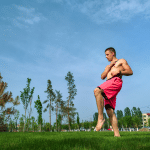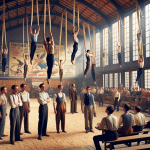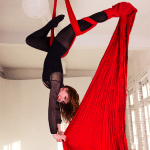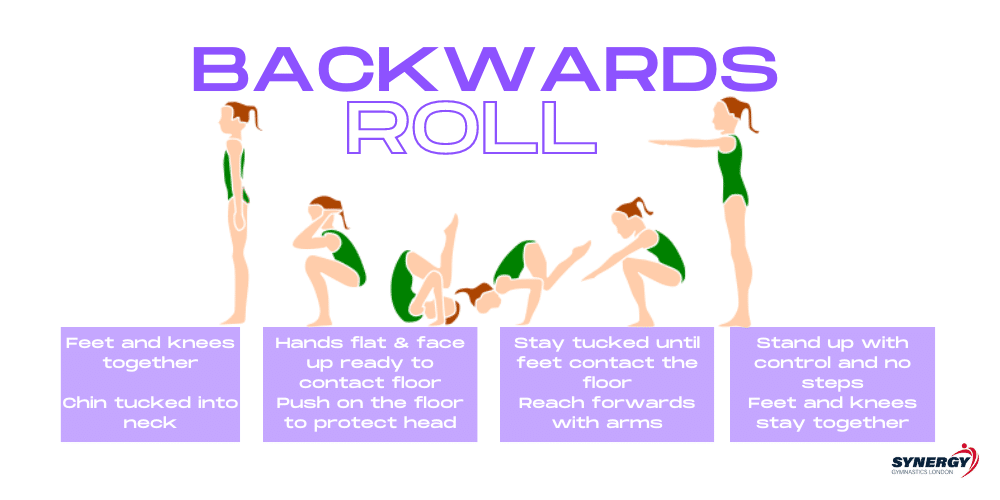
A backward roll in gymnastics is a basic move that all beginners should aim to learn within the first few weeks or months of training. A backward roll is a building block for learning more advanced moves such as back somersaults.
There are many variations of backward rolls that include different body shapes and can be combined with other gymnastics skills.
Being able to perform a backward roll in gymnastics can also help a gymnast fall safely when they make a mistake.
Disclaimer: Gymnastics carries an inherent level of risk. Information contained in this article does not replace the need for professional coaching in a recognized gymnastics facility.
Is a backward roll hard?
A backward roll can be hard for beginner gymnasts as they often use the head and neck to support themself. It’s also harder than a forward roll as many gymnasts are uncomfortable trying to roll without being able to see where they are going.
With the correct body shapes, technique and possibly some help from a coach, a backward roll can be mastered fairly easily. It also helps if you have a suitable gymnastics mat or cheese-shaped wedge mat.
As with any move that involves rotating upside down, it’s common to get dizzy at first but with enough repetition this will stop happening.
What are the steps involved in performing a backward roll?
As with all gymnastics skills, break a backward roll done into smaller steps and it becomes easier to learn and spot and fix errors.
What should be the start position in a backward roll?
When a gymnast first learns a backward roll they should start in a standing stretched shape before crouching down into a tucked position. Some coaches will use cheese-shaped wedge mats to start learning a backward roll. In this case, it is sometimes easier to sit down on the edge of the mat as it is like a crouched tuck shape.
However, to truly master a backward roll you should be able to start in a standing stretched shape.
How do you get over in a backward roll?
There are three key points in helping a gymnast rotate over in a backward roll.
- Have the hands facing upwards and placed above the shoulders so that as the gymnast rolls onto the back, the hands contact the floor. This will support the whole body and protect the head and neck by taking weight off them. The elbows should also be pressing in towards the head to ensure the arms stay strong.
- Keep the tuck shape as you roll. Tuck shape is the roundest gymnastics shape and is therefore the one that rolls the easiest. As a gymnast gets more advanced they can begin to roll in pike or straddle but the longer the shape, the harder it is to roll.
- Push through the feet to create momentum. It’s just like a jump so unless you create some power you will simply fall back, hit the mat and stop. Obviously, too much of a jump will make you hit the floor too hard so find the right balance of power to master your roll.
What should be the finish position in a backward roll?
To start with, a beginner gymnast should be happy to land on their knees however, you need to land on your feet and then stretch up in a straight body shape to be able to say you have mastered a backward roll.
The next step is to learn to finish in different body shapes. For example, finishing in front support shape, straddle shape or standing pike shape are common variations of a backward roll.
How do you practice a backward roll?
The best mat to practice a backward roll on has a slope or incline because when you roll downhill gravity helps a gymnast have more momentum. Cheese-shaped wedge mats have been specifically designed for this reason.
A high-end cheese mat from Tumbl Trak will cost around $165 on Amazon but if you’re looking for something on a smaller budget, check out this Matladin version for around $140.
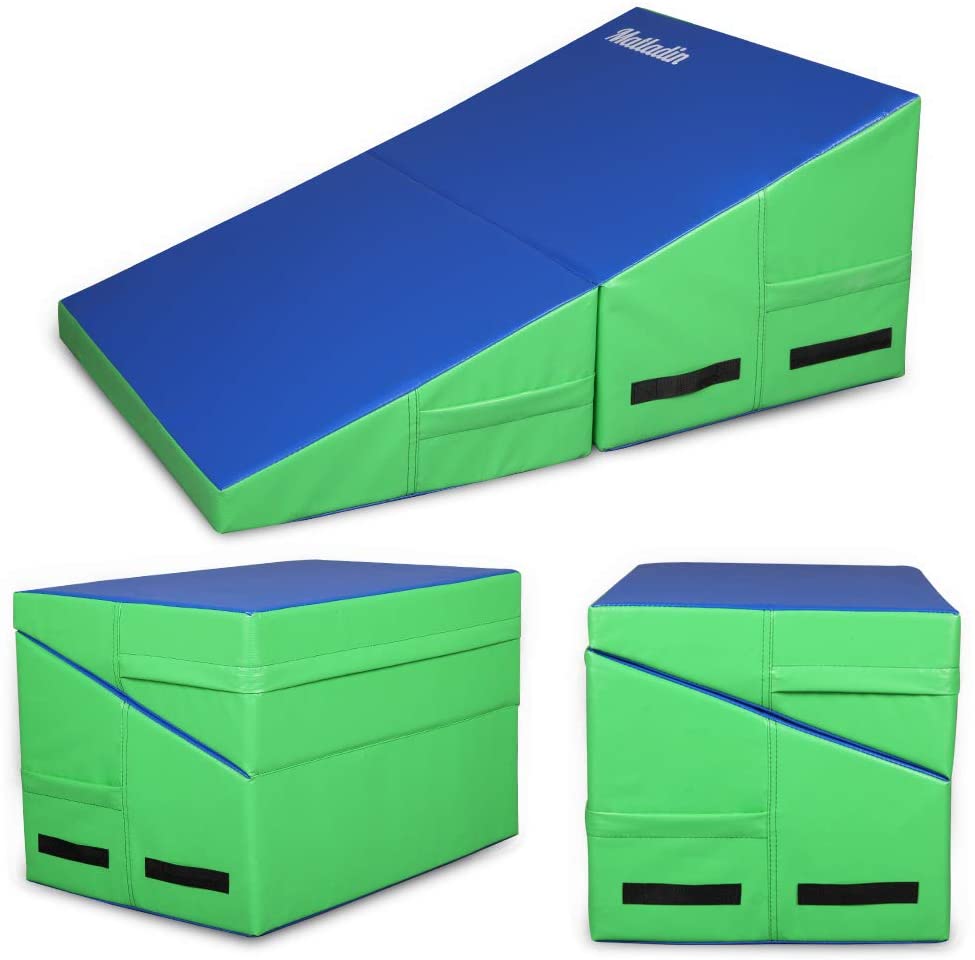
To practice your backward roll, sit at the top of the mat, facing backward and roll backward.
If a gymnast finds it too hard, there are a few drills they can practice to help.
- Rock back and forwards in a tuck shape.
- From standing, crouch and rock back without going over.
- Practice having the hands positioned back above the shoulders, ready to contact the floor and push off.
- If a gymnast struggles to be strong enough to push off with their hands, they should do some strength work like push-ups to help.
Having a coach spot you doing a backward roll will mean they can help take the weight off your hands and protect your neck so if you are struggling to learn a backward roll, investing in professional coaching is a sensible step.
Backward Roll Variations
Once a tucked Backward Roll has been mastered, gymnasts learn variations which include shape changes and combinations of other skills.
Backward Roll to Press Up Position
This version of a backward roll finishes in a Front Support shape which is the same as a Press Up position.
- Start in a standing position. Some gymnasts will crouch down into tuck next whereas others will keep their legs straight as they pike down. The advantage of keeping the legs straight at the start is that the finish position is also legs straight. It looks more aesthetically pleasing as well.
- Arms can either be bent so the hands are next to the shoulders or they can be kept straight as in a backwards roll to handstand.
- As the body rolls over it will extend (no need to hit handstand) and finish with straight arms and straight legs in the press-up position.
The backward roll to press up position is a great drill for the trickier Backward Roll to Handstand.
Backward Roll to Handstand
Backward Roll to Handstand is also known as Back Extension Roll and as the names suggest, involves the gymnast hitting the Handstand shape halfway through the roll.
An advanced gymnast will be able to hold the Handstand shape, whilst younger ones may pass through the Handstand shape without actually stopping in the Handstand.
- The starting position is standing straight with the arms above the head however, the hands should be turned with the palms facing upwards. Some gymnasts interlock their fingers, others will just place their hands so they slightly overlap each other.
- As the Backward Roll starts to move backward the arms should stay straight so that the whole arm contacts with the floor. The hands should also make contact with the floor, but as they are turned upwards it will be the side of the hands and the little fingers that first contact the floor.
- With the arms staying straight throughout, the gymnast then turns their hands out as they contact the floor and the body is upside down. This is the handstand phase of the roll.
- As with any other Handstand, the legs should be straight, the toes pointed and the head should stay neutral in between the arms.
- Finish the handstand by stepping backward one foot before the other.
Timing is key to mastering this skill. If you try and press into the Handstand too early, the back tends to over arch and kill the rotation but if you press too late, you miss the point at which you can hold a handstand in balance.
Straddle Backward Roll
The Backward Straddle Roll can be slightly easier for beginner gymnasts as the explosive separation of the feet is a good timer for pushing through the arms and hands on the floor.
- The starting position is usually in standing stretched but you could also start in piked standing or even start in straddle stand.
- The most aesthetically pleasing technique is to keep the legs straight on the entry into the roll but a gymnast could bend and crouch down as they start to roll.
- As the hands contact the floor, legs and feet separate into a straddle shape.
- Land in a standing straddle shape. Encourage the gymnast to show control by pausing with the back flat before standing up straight.
Backward Roll to Pike Stand
The Backward Roll to Pike Stand is a popular drill for young tumblers as it emphasizes the need to keep the shoulders and chest low and the back rounded as the feet contact the floor.
- The start position is standing stretched but I also like gymnasts to start in standing pike.
- As the gymnast starts to roll back it is tempting for them to put their hands behind their legs to cushion the impact but try to avoid this as it can cause loss of pike shape during the roll.
- Keep the legs straight throughout.
- Finish in standing pike with eyes looking down.
Shoulder Roll
The back shoulder roll is common in Rhythmic Gymnastics but is used less often in other disciplines.
All of the other starting and finish positions from other variations can be used however the shoulder roll only goes over one shoulder rather than two.
It looks pleasing when Rhythmic gymnasts use it in their choreography as it can link other skills and catches and creates a nice flow to the routines. However, in any other type of floor routine, it would usually be penalized!
Backward Roll on Beam
The Backward Roll on the beam is similar to the shoulder roll used in Rhythmic Gymnastics as it is not performed perfectly straight. It’s a pretty awkward skill and will take a while to master.
- Start in a sitting position on the beam.
- Lay back with knees bent and arms reaching back over your head.
- Grab the underneath of the beam with both hands and put your head to one side of the beam.
- Bring your knees over your head.
- Land one leg on the beam and the other along the side of the beam.
What are the benefits of backward roll?
A backward roll will help a gymnast understand the mechanics of a back somersault. Pullovers and Back Hip Circles on the Bar are essentially a backward roll whilst hanging. It also develops gymnast instinct to tuck and roll out safely from other skills they may have performed badly so it keeps them safer
For example, if a gymnast over-rotates at the end of a back handspring (or any other backward-facing skill), there is a good chance they will fall backward and land on their head or back. By rolling out they use and absorb the extra momentum until they regain their balance and control, thus avoiding injury.
A backward roll will also help develop strength in the arms, wrists, legs and core muscles.
Can you break your neck doing a backward roll?
It’s unlikely a gymnast will break their neck doing a backward roll however, it is still a real possibility that one should be aware of. It is common for a gymnast to pull a muscle in their neck doing a backward roll (which can be painful) but I have never personally seen or heard of a gymnast breaking their neck during a backward roll. I am sure it has happened – my point is that it is a rare occurrence.
This is especially true for beginner gymnasts who tend to put more weight on their head and neck as they are still learning to get their hands in the correct place to support the weight.
Even more advanced gymnasts will still have their head contact the floor but they have learned the skill properly to keep the pressure to a minimum.
Learn How to Backward Roll at Synergy
If you are looking for a class that teaches a backward roll in gymnastics properly, try one of our Gymnastics for All sessions for free. Simply visit our parent portal and create an account or drop us an email at info@synergygymnastics.co.uk
- What is Tricking? (Answered)Have you ever watched someone effortlessly blend martial arts, gymnastics, and dance into a breathtaking display of flips, kicks, and twists? That’s the art of… Read more: What is Tricking? (Answered)
- A Fascinating Guide to Aerial Silks HistoryAerial silks, the elegant and dynamic performance art where acrobats execute feats of strength and flexibility while suspended from fabric, has a history as rich… Read more: A Fascinating Guide to Aerial Silks History
- A Beginner’s Guide to Aerial SilksIf you’re looking for a unique and challenging workout, aerial silks may be just what you need. Also known as aerial gymnastics or aerial fitness,… Read more: A Beginner’s Guide to Aerial Silks
